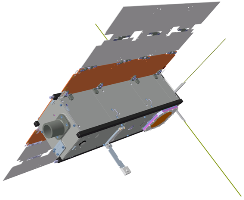| Name | ANSER (Advanced Nanosatellites Systems for Earth Observation Research) |
|---|---|
| Spacecraft type | CubeSat |
| Units or mass | 3U |
| Entity name | National Institute of Aerospace Technology (INTA) |
| Institution | Space agency |
| Entity | Government (Civil / Military) |
| Nation | Spain |
| Oneliner |
Constellation of 4 nanosatellites to monitor the quality of the water in reservoirs and swamps in Spain |
| Description |
The main goal of the ANSER project is to monitor the quality of the water in reservoirs and swamps in Spain, using technological advances to distinguish the different levels of contamination in its shallow layers. This set of nanosatellites will also allow the study of global warming caused by the increase of greenhouse gases in the atmosphere (especially the accumulation of carbon dioxide) and the effect that solar radiation has on our planet. The four nanosatellites of the ANSER mission will fly in close formation (about 10 kilometres apart) and they are ready to work together, as a single satellite, with fragmented payloads on the different CubeSats. They will be managed by a distributed attitude control to avoid disorientation and the loss of any of them. Alén Space’s Inter-satellite Link (ISL) system enables in orbit communications among satellites. This way, the ‘lead’ nanosatellite is the one in charge to connect with the ground station and to receive information from the other ‘follower’ nanosatellites, which allows the cluster to act as a single satellite. The ISL, which will operate in a 401-402 MHz radio frequency, can be optimised if its power and bitrate is modulated, thus allowing a greater transmission range among satellites, which in this mission could reach 100 kilometres. Main instruments:
|
| Results | |
| Sources | [1] [2] [3] [4] [5] [6] [7] |
| Photo sources | [1] [2] [3] [4] |
| COTS subsystems |
|
| Subsystems sources | [1] |
Related Spacecraft
| Name | Status | Launcher | Launch | Orbit |
|---|---|---|---|---|
| ANSER A Leader (Advanced Nanosatellites Systems for Earth Observation Research) | Deployment failure | Vega C, (VV23) | 2023-10-09 | 570 km, 97.67 deg |
| ANSER B (Answer Follower 1,, Advanced Nanosatellites Systems for Earth Observation Research, ANSER-FLW1) | Operational (Follower 1 took over Leader role as per news on 2024-05-27) | Vega C, (VV23) | 2023-10-09 | 570 km, 97.67 deg |
| ANSER C (Answer Follower 2, Advanced Nanosatellites Systems for Earth Observation Research, ANSER-FLW2) | Operational (Follower 1 took over Leader role as per news on 2024-05-27) | Vega C, (VV23) | 2023-10-09 | 570 km, 97.67 deg |
| ANSER Leader-S (ANSER-L-S, Advanced Nanosatellites Systems for Earth Observation Research) copy | not launched | Falcon 9, (Transporter-12) | 2025-01-14 | not launched |
| ANSER D (Advanced Nanosatellites Systems for Earth Observation Research) | cancelled? (was the constellation downsized and fourth is cancelled?) | cancelled | x_cancelled | cancelled |
Last modified: 2025-01-14








